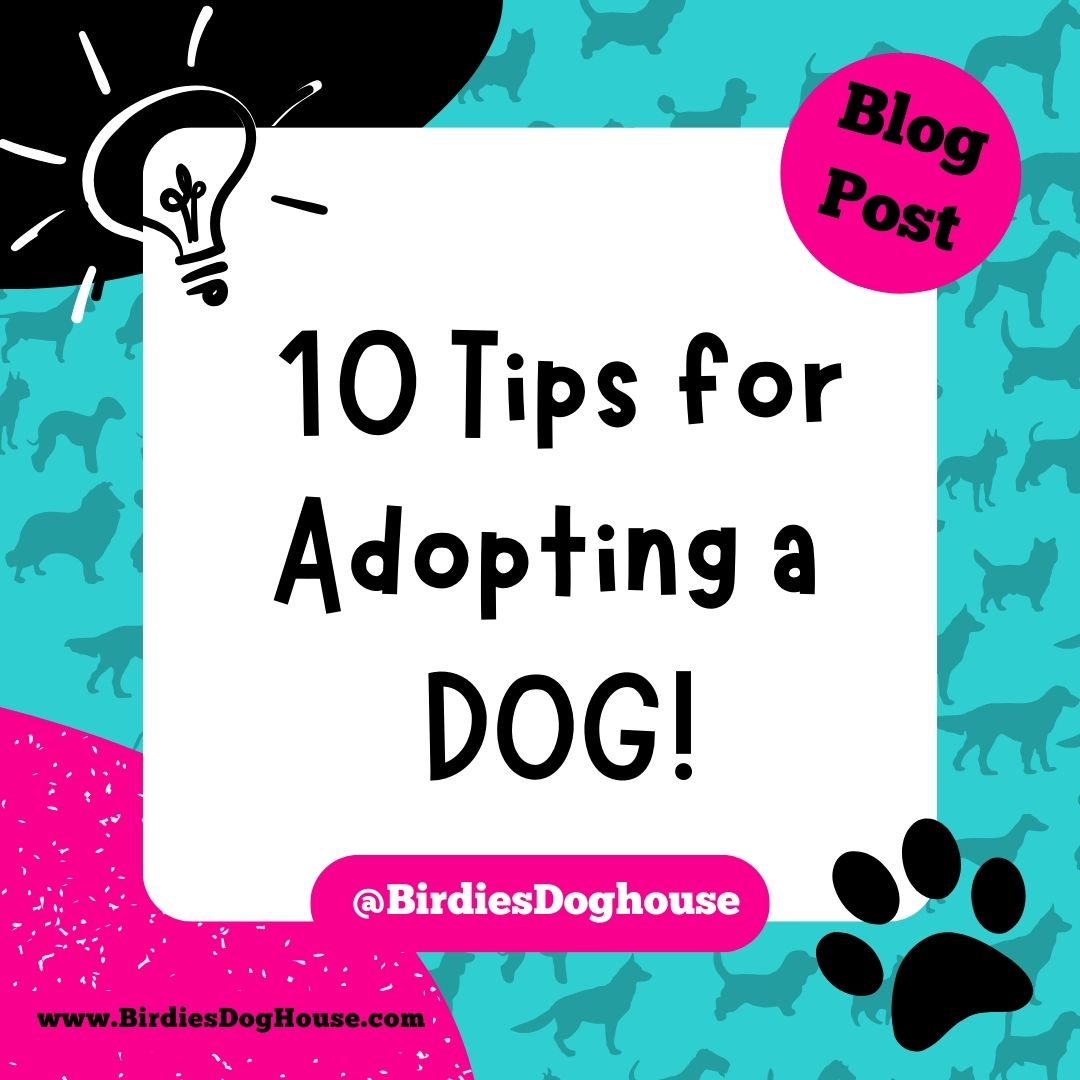10 Tips For Adopting A Dog (to Get Prepared):
Adopting a dog can be overwhelming if you don’t know where to begin, but bringing home a pup is also fun and exciting! Trust me we know at Birdies Doghouse because we have adopted several dogs and currently have 4 of them! Adoption is a milestone as the first bonding moment of many between you and your new furry friend. But, if you’re not prepared with these Tips for the First 30 Days After Adopting a Dog. You might find yourself having “adoption remorse”!
It’s important to know things like “What is the 3 3 3 rule for adopted dogs?” To help ease that stress, we’ve compiled a list of ten tips and things you can do to ensure a smooth transition for everyone when preparing to adopt a dog (before and after bringing him home). Learn How to Prepare and What to Expect When Adopting a Dog. Plus, Mistakes to Avoid When Adopting a New Dog with these Dog Adoption Tips for Bringing Home a New Rescue Dog!
-
Gather Your Dog’s Supplies
Get everything you’ll need to make your new dog feel safe and comfortable before bringing them home. In addition to the basics—a collar and leash, as well as food and water bowls—you’ll also need a dog bed, pet gate, toys, treats, and grooming supplies. It’s also a good idea to have training pads and enzymatic cleaners on hand for accidents in the early stages of house-training.
- Dog Collar
- Dog Leash
- Personalized Dog Tag
- Dog Food & Water
- Dog Bowls
- Dog Bed
- Pet Gate (or Crate)
- Dog Toys
- Dog Training Treats
- Grooming Supplies
- Potty Training Pads
- Bissell Spot Cleaner Vacuum for Pets
-
Prepare Your Home for Fido
Similar to babyproofing, it’s always a smart and safe idea to ready your space before your dog comes home. Walk through your home and stow away items that might be harmful to small or overly curious pups, and pick up those items you don’t want to get chewed.
You should prepare everyone else in the household too, especially if you have children in your home. Discuss which members will take up feeding, walking, and training.
If other animals already live in your home, be sure their shots are up-to-date for everyone’s safety. And you should have a designated area where they can retreat, giving them a way to acclimate to the new dog’s arrival on their own time. This may seem like overkill to some, but this preparation helps keep your pooch safe and eases everyone in the transition process.
-
Assign a Safe Space for Your Dog
Just as you would for existing pets, make the same private space for your new one. Some pet parents have an aversion to dog crates, so try a comfy dog house or dog bed (covered) instead. They also serve as a place to feel safe while they adjust because most dogs prefer to have their own space, much like a child does in their own room.
You might also try using a pet gate to block off a room just for them. You can visit your new dog there to help the bonding process, but keep kids and other pets out for the time being.
-
Plan How (and When) to Bring Him Home
If possible, take a few days off work or plan to pick your dog up on a weekend when you have free time to help them adjust. But don’t pick him up at the beginning of a long vacation; if he gets used to you constantly being home, he can develop separation anxiety when you go back to work. Have someone else drive you to pick him up, or ride along to help comfort him while you drive. Don’t forget to take his collar and leash, and bring him straight home without making any distracting stops.
-
Show Your Dog Around Inside House
Keep your dog on a leash as you let them explore and sniff inside. Show them around to their food, water, bed, and toys. Let him know what’s off limits with short but firm commands such as “no” or “stop.” Don’t immediately start reprimanding your new fido friend or they may become fearful. Be gentle but firm in your training.
-
Explore the Yard Outside on a Leash
Adopted dogs should have plenty of time and space to sniff out their new surroundings. If you’ve designated a potty space in your yard, lead him to it and reward him with a treat when he uses it successfully. Also, consider placing potty training pads next to exit doors you want your dog to learn to go out through.
-
Introduce Fido to the Family
It’s recommended to introduce new household members and other dogs outside one at a time to meet the new canine. Keep other dogs on their leashes and supervise their interactions, keeping in mind that too heavy an introduction can cause them to become territorial with the new arrival. Restrain kids (and other parents) from kissing or hugging the dog (however adorable they may be). Give the new dog time to adjust and let them be the first to approach!
-
Switch Your Dog’s Food Slowly
If you can, incorporate some of the food the shelter or breeder was feeding Fido, and gradually switch your dog’s food to the brand you intend to serve him regularly in order to avoid digestion issues due to too quick a change. Don’t be surprised by an upset stomach due to diet or the new living situation. Sometimes it takes dogs time to adjust to their new surroundings, imagine how you might feel in a new strange home with new pup parents?
-
Begin Training Your Dog Right Away
Even adult dogs who were previously housebroken will require a little house training. If you plan to crate train your dog, introduce him to his crate right away, and practice leaving them in it—with a toy—for short periods while you step out of the house to let them acclimate. You might even want to consider taking a formal obedience training course with your dog. Although, You’ll still want to start working with him to establish the rules from day one. Again, don’t immediately reprimand your dog to make them fearful especially since you don’t know their prior environment. Be firm but gentle in your corrections.
-
Get Your Dog Checked by a Vet
Within a week of bringing Fido home, you should visit a veterinarian for a health check and to make sure he has all his vaccinations if this wasn’t already performed at the shelter, breeder, rescue, etc…
Preparing to adopt a dog involves several key steps to ensure a smooth transition for both you and your new furry friend. Here’s a summarized version of the tips provided:
- Gather Supplies: Get all the necessary items like food, water bowls, bed, toys, grooming supplies, and cleaning products.
- Prepare Your Home: Make your space safe by removing hazards and designating areas for your dog.
- Assign a Safe Space: Set up a comfortable and secure area for your dog to retreat to.
- Plan How to Bring Him Home: Choose a time when you can spend time with your new dog to help them adjust.
- Show Him Around Inside: Introduce your dog to his new indoor environment gradually.
- Explore the Yard Outside: Let your dog familiarize himself with the outside area, especially the potty spot.
- Introduce Him to the Family: Introduce new household members and other pets slowly and carefully.
- Switch Food Slowly: Transition your dog’s food gradually to avoid digestive issues.
- Begin Training Immediately: Start training your dog right away, but be gentle and patient.
- Get Him Checked by a Vet: Take your dog to the vet within a week of bringing him home for a health check and vaccinations.
Adopting a dog is a big transition for both the dog and your family. Following these steps will help your new dog feel secure in his new surroundings and make it easier to bond with your new wet-nosed furry friend. Plus, covering these basics will make your dog feel more secure and ease the transition into his new home. Be sure to SUBSCRIBE to our Newsletter for more tips and tricks!
Related:
- What is the 3 3 3 rule for adopted dogs?
- Dog Adoption Tips for Bringing Home a New Rescue Dog
- 10 Mistakes to Avoid When Adopting a New Dog
- How to Prepare and What to Expect When Adopting a Dog
- 10 Tips for the First 30 Days After Adopting a Dog

